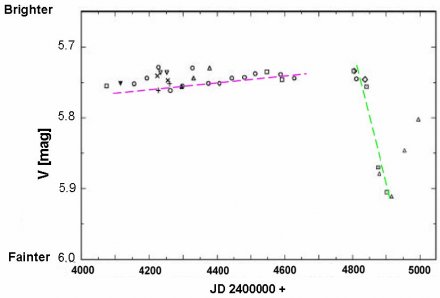Hα-emission and V-correlations as probes of Be stars disks
Tuesday 20 December 2011 by Ernst Pollmann
Introduction
An interesting discussion among professional Be star disk researchers has, for years, been the question of correlation between the Hα equivalent width (EW) to the UBV brightness [1]. Researchers at the University of Western Ontario (Canada) are currently trying to refine a computer model to support such already observationally proven correlations [2].
The so-called non supergiant B-stars, as particularly fast rotating objects show, depending upon presence of a gas disk, Balmer emission lines in their spectra (as for instance the Hα line) and sometimes not. The presence of a gas disk, and hence emission lines, thereby characterize a B-star as Be-type (e = emission), whereby different emission lines such as those of HeI, FeII, SiII and MgII are sometimes observed [2]. A further characteristic of this star class are the typical short and long-term spectral variations.
The observer’s line of sight (inclination i) has a major impact on the spectral profile. In the case of the so-called “pole-on” stars the observer views from above, perpendicular to the rotation axis of the star and its gas disk (i = 0°). In the case of an inclination 90°, the star is a so-called “edge-on” star, i.e. the observer views almost the edge of the Be star gas disk.
Positive Hα and V-correlations
For the Be-stars γ Cas, 28 Tau, κ Dra, EW Lac (and others) it has long been observed, that the stronger the Hα emission is, the larger is the V-brightness of the star. The following stars are seen both, pole-one and intermediate angles of inclination: 45° (γ Cas), 57° (κ Dra), 68° (EW Lac) 90° (28 Tau).


The two plots in fig. 1 & 2 show our measurements of Hα EW for γ Cas and 28 Tau with their corresponding V-brightness. For γ Cas it was only possible to use the visual estimates of Ferenc Puscas (Hungary) and DSLR measurements of Wolfgang Vollmann (Austria) for the V brightness, whereas for 28 Tau Sebastian Otero (Argentina) made available his own estimates (also visual) and of other sources. A further example of a positive Hα-EW vs.V correlation would be the quasi pole-one star (i = 68°) κ Draconis (fig. 3).

Inverse Hα and V-correlations
Correlations of this kind, i.e., the stronger Hα-emission is, the weaker in V is the star, are seen only with the so-called edge-on stars. Typical representatives of this are 4 Her (in fig. 4), 88 Her, V1294 Aql and η Cen.


Hα- and V-correlations

The model in fig. 5 of Harmanec [5] tries, using the individual star inclination (i.e. the observer perspective), the positive and inverse correlation with the available data of Hα EW and V-brightness, to consolidate. Another approach [2], using special computer model codes of Be star disks, and including further selected objects and newest, modern knowledge of modelling Be star disks, to describe the influence of the disk thickness and the gravitation darkening effect of the EW vs. brightness correlations.
References:
[1] Slettebak, A., PASP, 100, 770-784, July/1988
[2] Patel, P., University of Western Ontario, priv. Mitteilung Oktober 2011
[3] Juza, K., et al., Astron. Astrophys. Suppl. Ser. 107, 403-411, 1994
[4] Koubsky, P., et al., A&A, 328, 551-564, 1997
[5] Harmanec, P., Hvar Obs. Bull. 7, 55, 1983
Ernst Pollmann; eMail: ernst-pollmann(at)t-online.de
Wolfgang Vollmann; eMail: vollmann(at)gmx.at
Ferenc Puscas; eMail: emoferenc2008(at)freemail.hu
